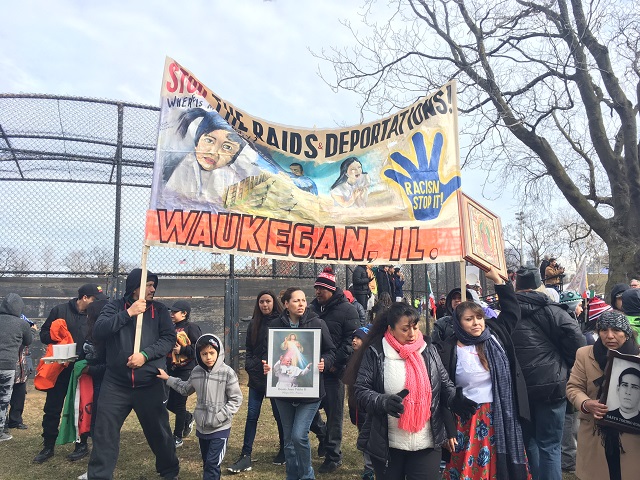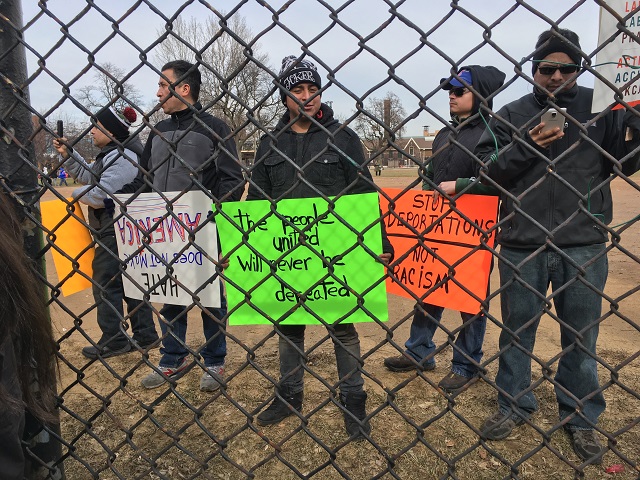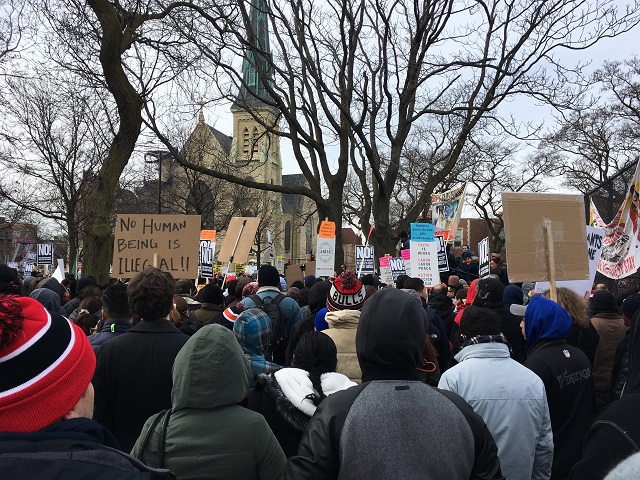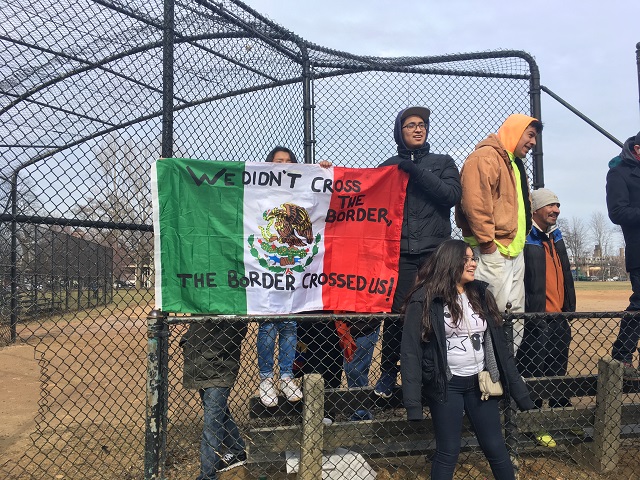
“Everybody who is here illegally is subject to removal at any time,” White House press secretary Sean Spicer said Tuesday, confirming the assault that the Trump administration is waging against undocumented people in the US. Earlier that day, the Department of Homeland Security (DHS) had shed light on how immigration laws might be enforced under Trump by issuing two new memos on the topic.
Immigrant communities have been on high alert since Monday, February 6, when US Immigration and Customs Enforcement (ICE) began what they called a “national targeted fugitive operation enforcement effort.” By week’s end, 680 immigrants across the country had been rounded up for deportation. Grassroots organizations across the country were quick to react, providing legal support and community education, and taking to the streets to call out the government’s targeted attacks.
For community organizers like Julieta Garibay, the ICE raids were concrete proof that Trump intends to make good on his campaign promise to deport undocumented immigrants. Garibay is a cofounder of United We Dream, an immigrant youth-led national organization. She notes that throughout Trump’s presidential campaign, he made “a lot of threats against immigrant communities,” from mass deportation to ending Deferred Action for Childhood Arrivals (DACA), a program set up by President Obama that allows undocumented youth who entered the country as children to work and study here legally on a temporary basis.
“All these threats have been happening for almost a year and a half, during his entire campaign, and now he’s just making them a reality,” Garibay says. “I think what happened the past two weeks really has laid out what worries many of us and what’s keeping us up at night.”
This point was confirmed by the President on Friday, during his speech at the Conservative Political Action Conference at National Harbor in Maryland. “We’re getting bad people out of this country, people that shouldn’t be, whether it’s drugs or murder or other things,” he said, of the recent immigration enforcement efforts. “Those are the ones that go first, and I said it from Day One. Basically all I’ve done is keep my promise.”
 Protesters arrive at a rally in Union Park, Chicago on February 16, 2017 to draw attention to the contributions immigrants make to society. (Photo: Kerry Cardoza)
Protesters arrive at a rally in Union Park, Chicago on February 16, 2017 to draw attention to the contributions immigrants make to society. (Photo: Kerry Cardoza)
Trump first focused his sights on immigration on January 25. That Wednesday, the president signed executive orders calling for increased border security and spelling out which undocumented immigrants would be prioritized for deportation. He also called for the hiring of 5,000 additional Border Patrol agents and 10,000 additional immigration officers at ICE. Meanwhile the DHS memos issued Tuesday clarify some of the points made in the earlier executive actions, namely that: “All of those in violation of immigration law may be subject to immigration arrest, detention and, if found removable by final order, removal from the United States.”
Advocates are quick to point out that deportation numbers were also high under President Obama. According to Politifact, more than 2 million immigrants were deported under Obama’s tenure. Similar to Obama’s priorities, Trump has long made clear that he intends to deport so-called “criminals.” His executive action, however, greatly expands who might fall under that category. The wording encompasses anyone who has been charged with any criminal offense, even if they have not been convicted, as well as anyone who might “pose a risk to public safety or national security” in the judgment of an immigration officer.
Some have noted that under these provisions, any undocumented immigrant could be a potential ICE target. In a fact sheet made available by ICE following the early-February raids, the agency notes that they arrested “convicted criminal aliens and other immigration enforcement priorities” Yet lawmakers who met with ICE officials last week told The Washington Post that the agency admitted that “at least 186 of those apprehended in recent days had no criminal history.”
The raids have created a lot of fear and uncertainty in immigrant communities and among those advocating on their behalf. Mayra Joachin, a staff attorney at the National Immigration Law Center, urges people who are afraid of being targeted by ICE agents to contact a local immigration-rights organization and educate themselves on their rights. “Right now there’s a lot of fear because people don’t know how the raids are happening,” she says. “There’s a lot of confusion.”
Julieta Garibay says a lot of the undocumented members of her organization are worried about being potential targets. “The executive order that Trump has put out is basically saying, every single person who’s not born here, who’s an immigrant, who’s undocumented, is a target of deportation under his term,” she says. “That’s what we’re trying to fight against, and reminding our community that we need to continue organizing, continue protecting each other and developing a deportation defense network that will keep our families and communities together.”
A Day Without Immigrants
Trump’s administration has been acting quickly since Day 1, and immigration activists have responded in kind. On February 13, immigrant workers in Wisconsin held a “Day Without Latinos, Immigrants and Refugees” and then on February 16, cities across the country participated in the broader “A Day Without Immigrants.” Immigrants and allies alike stayed home from work and school, and boycotted businesses in order to highlight the contributions of immigrants to society.
In Chicago hundreds of people gathered at Union Park for a rally before marching downtown, where their numbers grew. Construction workers, local politicians and community organizers mingled at the park, often breaking into chants of “Sí, se puede” (“yes, we can”). The event was coordinated quickly by Arise Chicago, a local workers’ rights organization, and was co-sponsored by the Chicago Community and Worker’s Rights center and Organized Communities Against Deportations. Shelly Ruzicka, the communications and development director for Arise Chicago, says the event came about through “very grassroots and organic movement.”
 Protesters gather in Union Park, Chicago for “A Day Without Immigrants” rally on February 16, 2017. (Photo: Kerry Cardoza)
Protesters gather in Union Park, Chicago for “A Day Without Immigrants” rally on February 16, 2017. (Photo: Kerry Cardoza)
“We were hearing both from our own member-workers and from workers we didn’t know who were calling us, saying, you know, ‘We heard about this Day Without Immigrants, kind of spring[ing] up organically online and we want to do something,'” she says. “For us, it was really creating that space for people to meet together, to have that collective space, raise a collective voice, feel like they weren’t just giving voice to their employers or the economy or society writ large, but to really have an outlet to have that much bigger presence.”
At many of Thursday’s protests around the country, youth made up a large portion of the crowd. More than 50,000 students did not attend Chicago Public Schools on Thursday, according to DNAinfo. The LA Times reported that 3,000 more students than usual were absent from Los Angeles Unified Schools. About 9,000 students were absent that day in LA County’s Long Beach School District and American University radio reported that in Washington, DC, at least two schools closed for the day.
Ruzicka from Arise Chicago says she hopes Thursday’s protest helped assuage some of the community’s fears. “People are afraid of what they’re hearing, but they also know we can come together and make our voices heard,” she says.
“Know Your Rights, Know Your Power”
Many immigrant-rights’ groups have refocused “Know Your Rights” workshops that were already in place, in response to Trump’s policies. Asian Americans Advancing Justice | Chicago has refocused its workshops to “Know Your Rights, Know Your Power.” The curriculum teaches participants what to do if they are stopped by local or federal agents but also “adds an element of being proactive,” says Brandon Lee, the group’s communications and research coordinator. “A big message behind the ‘Know Your Rights, Know Your Power’ is: community is protection is power,” he says. “Being in community and building community is connected with safety. There’s safety in those numbers, and there’s power in those numbers.”
United We Dream has been swift to respond to Trump’s executive actions. Organizers with the group are actively working on the case of Daniel Ramirez Medina, a DACA beneficiary in Washington state who was taken into custody by ICE during a raid on his father’s home on February 10. Ramirez remains in custody. United We Dream is circulating a petition to DHS Secretary John Kelly asking for Ramirez’s immediate release.
On February 17, First Defense Legal Aid in Chicago hosted a panel on “CrImmigration Law” (alluding to how the law criminalizes immigrants). Free and open to the community, the panel convened local experts to share information on immigrants’ rights and the nuances of Chicago’s status as a sanctuary city. Theoretically, police in sanctuary cities do not keep suspected undocumented immigrants in jail in order for federal authorities to evaluate their immigration status. But this policy is not always put in practice.
“In Chicago, the police, our police are not supposed to be policing immigration status,” says Eliza Solowiej, executive director at First Defense. “But our Chicago police are not supposed to do a lot of other things that it’s been shown that they do.” Solowiej says she has seen instances where undocumented immigrants in Chicago police custody have had their status leaked to federal agents.
How to Resist
Many organizations noted an uptick in calls for information and advocacy in recent weeks, meaning that volunteers are needed more than ever. There are plenty of ways to get involved in resisting the administration’s targeted attacks on immigrants and communities of color, from organizing events to volunteering to answer hotline calls to directly protecting immigrants at risk of being deported.
Shelly Ruzicka of Arise Chicago suggests finding a community organization to get involved with. “Turn to the groups for something that you’re passionate about, whether it’s connecting to your own identity or something that you care about, and really connect,” she says.
 Students carry a homemade sign at Chicago’s “A Day Without Immigrants” rally. Over 50,000 did not attend Chicago Public Schools on February 17, 2017. (Photo: Kerry Cardoza)
Students carry a homemade sign at Chicago’s “A Day Without Immigrants” rally. Over 50,000 did not attend Chicago Public Schools on February 17, 2017. (Photo: Kerry Cardoza)
Asian Americans Advancing Justice | Chicago is spearheading a social media campaign, 100 Days of Resistance. Participants are invited to share how they are resisting online using the hashtag #100DaysOfResistance. The organization also has a calendar on its website tracking local actions that people can take part in, as well as a toolkit offering practical advice on political organizing. Brandon Lee, the group’s communications and research coordinator, says that working with other communities is vital to the fight.
“Sometimes it can seem a little hopeless, right?” Lee asks. “But try to remember that part of resistance is not only being proactive but really leaning into the idea of community. And not only within the Asian American community, but within the Latino community as well.”
United We Dream has also launched a social media campaign for allies to easily get involved. Text “HereToStay” to 877877 and make a pledge to show up for immigrants in your community. Participants will be notified when there is action needed locally, whether it’s at a rally, a city council meeting where anti-immigrant policies are being discussed, or a raid. “It’s basically a network of allies saying, ‘I’m going to stand up in this moment when there is so much hatred,'” says organizer Julieta Garibay. “‘I want to show up for immigrants with love and show them that they’re not alone.'”
Join us in defending the truth before it’s too late
The future of independent journalism is uncertain, and the consequences of losing it are too grave to ignore. To ensure Truthout remains safe, strong, and free, we need to raise $43,000 in the next 6 days. Every dollar raised goes directly toward the costs of producing news you can trust.
Please give what you can — because by supporting us with a tax-deductible donation, you’re not just preserving a source of news, you’re helping to safeguard what’s left of our democracy.